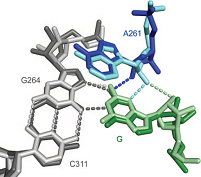Ongoing Research Topics
The overarching goal of the Herschlag Lab is to understand the fundamental behavior of RNA and proteins and, in turn, how these behaviors determine and impact biological catalysis and biology. The lab takes an interdisciplinary approach, spanning and integrating physics, chemistry and biology through fruitful interactions with collaborators and a wide range of techniques are employed.
Ketosteroid Isomerase Catalysis
Enzyme Promiscuity, Evolution, and Phosphoryl Transfer
RNA Catalysis
 With the discovery nearly thirty years ago that RNA can catalyze reactions with proficiencies that approach those of protein enzymes, the central dogma of biology with RNA as a simple carrier molecule between DNA and proteins was overturned. Today RNA is recognized as an active player in biology, both as naturally occurring RNA enzymes or ribozyme, including the ribosome and likely the spliceosome, These findings, and the fundamental ability of RNA to act both as an efficient information carrier and functional macromolecule have led to wide speculation of the existence of an RNA World early in evolution.
With the discovery nearly thirty years ago that RNA can catalyze reactions with proficiencies that approach those of protein enzymes, the central dogma of biology with RNA as a simple carrier molecule between DNA and proteins was overturned. Today RNA is recognized as an active player in biology, both as naturally occurring RNA enzymes or ribozyme, including the ribosome and likely the spliceosome, These findings, and the fundamental ability of RNA to act both as an efficient information carrier and functional macromolecule have led to wide speculation of the existence of an RNA World early in evolution.
Thus, we explore RNA catalysis for several reasons: to learn more about the catalytic potential of RNA, how it evolved, and how it may someday be co-opted for medical, technological and industrial processes; to learn about the RNA molecules that function in modern-day biology and define its capabilities and limitations; and to provide a counterpoint to the vast knowledge of protein enzymes in order to help decipher what is fundamental to biological catalysts.
We are currently focused on the group I ribozyme, the most well-studied catalytic RNA in both structure and function. We harness previous studies, including multiple crystal structures, a robust phylogeny model, and a defined kinetic and thermodynamic framework for the Tetrahymena group I ribozyme, to delve more deeply into questions about catalytic RNA and how an RNA scaffold can be used to sculpt an active site. Some questions of interest include: What are the structural and functional roles of metal ions within the ribozyme, both inside and outside of the active site? What are the ways in which long-range interactions, distant from the active site, establish the active site and affect structure and activity? In what manner do specific hydrogen bonds modulate ribozyme function throughout the course of the reaction? We are also very interested in RNA conformational changes, as these transitions are key elements in nearly all RNA-mediated events.
To answer the aforementioned and additional questions, we use techniques including site-directed mutagenesis and site-specific chemical modifications to alter both the ribozyme itself and its substrates. The replacement of single functional groups within a complex RNA structure with multiple related functionalities is straightforward, whereas the corresponding replacements in proteins remains highly challenging. Function is probed via pre-steady state kinetics, and structure is probed using a battery of chemical footprinting approaches. Recent advances allow us to incorporate probes of local dynamics and single molecule fluorescence assays of functional conformational transitions.
Some leading papers from the lab in the area of RNA catalysis are:
See also: Faculty of 1000 Biology, Feb 2009 http://www.f1000biology.com/article/id/1156905/evaluation